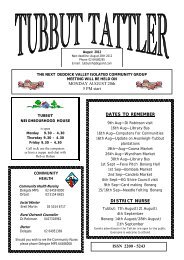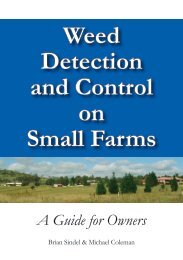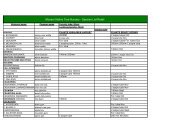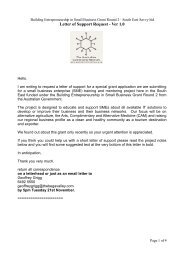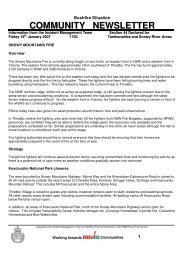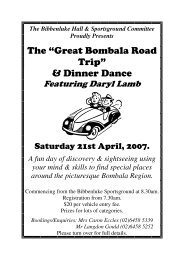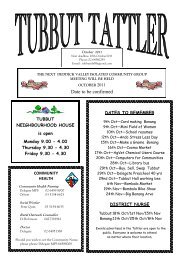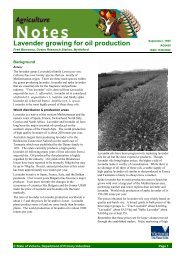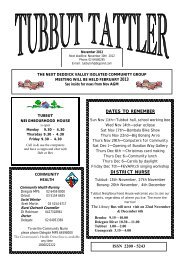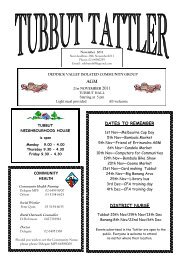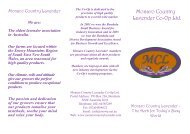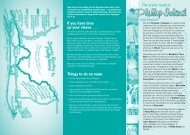September 2011 Tattler.pdf - Platypus Country
September 2011 Tattler.pdf - Platypus Country
September 2011 Tattler.pdf - Platypus Country
You also want an ePaper? Increase the reach of your titles
YUMPU automatically turns print PDFs into web optimized ePapers that Google loves.
Remembering our past—Martins Creek<br />
The Local Rag 38 (May 1982) published an article by Marg<br />
Quinn (Quinnethe) which told the story of the lively days of<br />
Martin‟s Creek, where now there is little to meet the eye.<br />
When Peter Jensen, a Dane, travelled to Martins Creek<br />
with his fellow countryman Henry Gangelhoff in 1890,<br />
he believed that a railway line would go through there,<br />
connecting Orbost and Bombala. In fact, the proposed<br />
railway was surveyed three times. So he took up his<br />
selection there, beginning work on the day of arrival, to<br />
clear enough space among the dense wattles to put up<br />
a tent. The track they rode to get there had been<br />
blazed about 1878 by Hamilton Reed and C.W.<br />
Nicholson during a trip to Orbost which took them four<br />
days. Around the time that Jensen moved to Martins<br />
Creek, a twice weekly mail run was established<br />
between Orbost and Delegate. The first hut built by<br />
Jensen and Gangelhoff was destroyed almost<br />
immediately by a falling tree and they had to start all<br />
over again. Later Peter built a four-roomed house, all<br />
the timber coming from one big white gum.<br />
In 1983, Peter married Sophie Gangelhoff who he had<br />
met at Colac. Although she had never been on a horse,<br />
she was hoisted up at Orbost Station for the long ride<br />
to Martins Creek. This took two days, with an overnight<br />
stop at the Beveridges at Sardine Creek. On arrival at<br />
Martins Creek, she had to adjust to cooking over the<br />
fire in a camp oven and washing a little at a time in a<br />
four gallon kerosene tin. To keep the house supplied,<br />
Peter rode to Orbost leading a packhorse and returned<br />
on foot with both horses loaded.<br />
The Jensens cleared an area around the house and in<br />
1896, Sophie gave birth to daughter Louise in Orbost.<br />
The bush was so dense and the bracken so high that<br />
Sophie‘s main concern was that the little girl would get<br />
lost when she started walking. To keep track of her<br />
movements, she tied a sheep bell around Louise‘s<br />
neck, which could be heard a mile away.<br />
After the track was made, the Jensens extended the<br />
house, adding rooms and a bar, and got a licence for<br />
what became the Danebo Hotel which flew the Danish<br />
flag. Peter made the barrels too. Life now became<br />
frantically busy as travellers and drovers broke their<br />
two day trip between Delegate and Orbost by staying<br />
overnight at the hotel. There were many drovers and<br />
bullockies who couldn‘t afford to stay the night; they ate<br />
at the hotel and camped out.<br />
Days began early to do all the work. The fires had to be<br />
lit, the cows milked, the bread baked and meat cut off<br />
the carcasses in the cool room before the guests had<br />
breakfast. After guests departed, rooms had to be<br />
cleaned, beds changed, cheese and butter made, the<br />
bar cleaned up and the evening meal prepared, all<br />
before the arrival of the next round of guests. Each<br />
day‘s potatoes were peeled the night before, behind the<br />
bar, between customers—a bucket full a day! There<br />
was also the washing, which was done in a laundry<br />
built onto the back of the hotel, the water coming down<br />
a hand cut water race which went three-quarters of a<br />
mile into the bush. This needed constant maintenance to<br />
clear fallen leaves and bark and plug up the holes dug<br />
by crabs.<br />
When Louise was about five years old, a second child<br />
was born, a sickly, fretful baby which Sophie had to carry<br />
around while coping with all the other demands of her<br />
life. There were also many trips to the doctor in Orbost<br />
so, in 1906, Sophie hired a 13 year old girl to help. The<br />
little girl became Mrs Jane Auger of Frankston, who<br />
Marg interviewed in compiling this article.<br />
Jane ran the household, including skinning and cutting<br />
up the ration sheep, while Sophie Jensen was away with<br />
the sick child, who died before the age of four. Her work<br />
continued when the third child, Sophie (Malinn) was<br />
born—all for a shilling a week and her keep for nearly<br />
two years.<br />
Louise, who was capable of running the house, far<br />
preferred to work outside with the cattle and horses and<br />
did so whenever she could be spared. She broke the<br />
horses in and shod them and helped to muster the<br />
cattle.<br />
Large mobs of cattle and sheep passed through Martins<br />
Creek heading from the Monaro to Warragul. Flocks of<br />
turkey were enticed down the road by one person<br />
scattering handfuls of grain in front of them. At dusk the<br />
turkeys would fly up and roost in the trees and their<br />
drovers make camp. At dawn when the turkeys<br />
descended, the journey would recommence. Pigs were<br />
trained to follow a cart filled with feed—although there<br />
were breakaways.<br />
Swaggies were a common sight on the road, usually<br />
travelling in small groups. Indian hawkers travelled<br />
through with their wares in carts or saddlebags. Sophie<br />
remembered one of these hawkers pulling a knife on her<br />
mother in the bar after she refused to give him more to<br />
drink. ―Me kill you,‖ he said, holding the knife to her<br />
throat. ―Well kill me then,‖ said Sophie‘s mother, and the<br />
hawker put the knife back in his pocket and walked off.<br />
Peter was away, working on the roads, at the time.<br />
Sophie attended school by correspondence, hard<br />
enough for most children but doubly so for a child whose<br />
parents were unfamiliar with English. The teacher during<br />
the first six years was kind and helpful, explaining things<br />
clearly. But in seventh year, the teacher was more<br />
demanding and intolerant. Sophie said, ―If a blot of ink<br />
dropped on the page, the first teacher would comment,<br />
‗What a pity you spoiled your work‘ while the second<br />
would just write ‗Dirty work!‘‖ Discouraged by this,<br />
Sophie gave up and did her learning alone. A lesson for<br />
other teachers perhaps?




